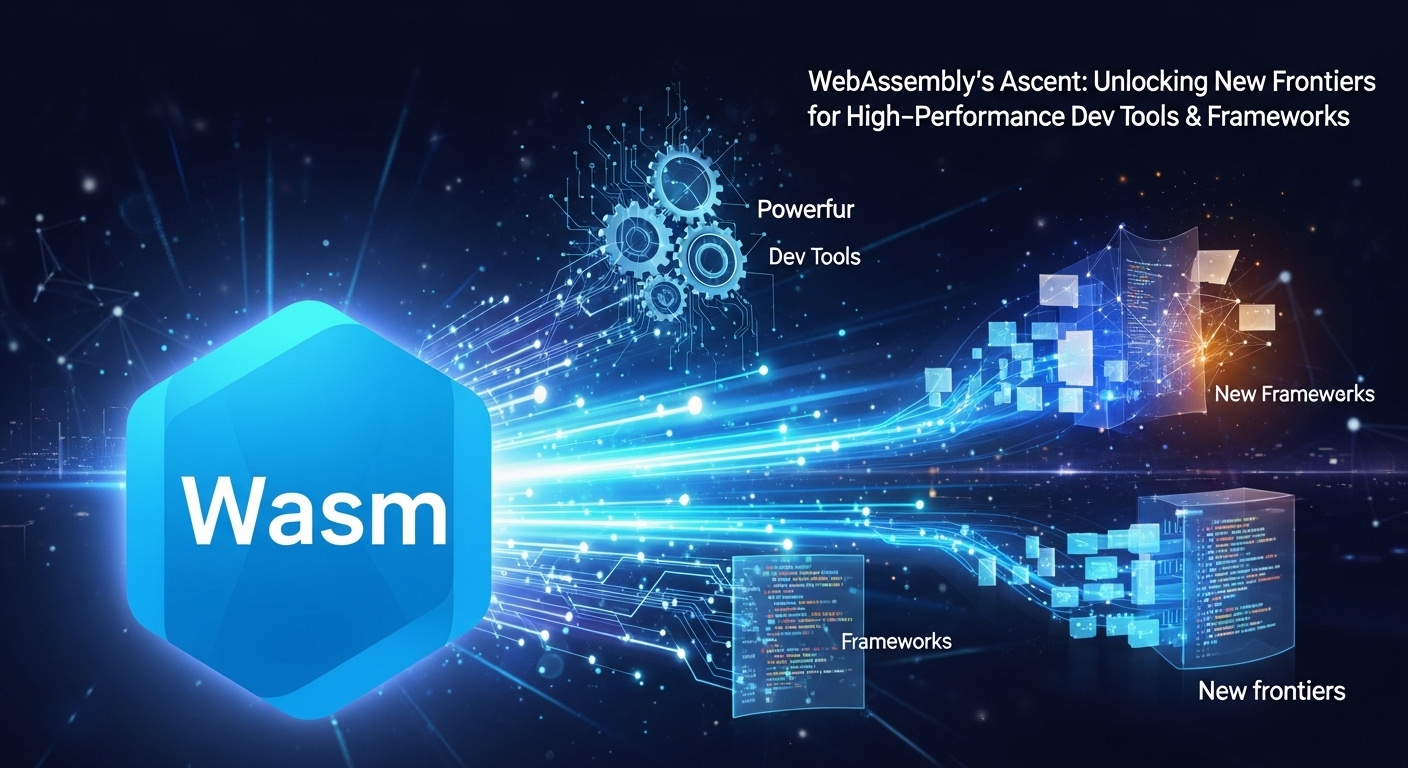The Web is Evolving, and It’s Getting Faster
For decades, JavaScript has been the undisputed king of the web. It’s the language that brought interactivity to static pages and powered the rich, dynamic applications we use daily. But as our ambitions for the web have grown, so have the performance demands. Complex applications like in-browser video editors, 3D design tools, and large-scale data visualizations often push JavaScript to its limits. The dynamic, interpreted nature of the language, despite incredible optimizations from JIT (Just-In-Time) compilers, can become a bottleneck.
Enter WebAssembly, or Wasm for short. It’s not a new programming language meant to replace JavaScript. Instead, think of it as a powerful new partner. WebAssembly is a low-level, assembly-like language with a compact binary format that runs with near-native performance. It’s designed to be a compilation target for high-level languages like C++, Rust, and Go, allowing developers to run code on the web that was previously confined to desktop applications. This paradigm shift is not just a minor upgrade; it’s unlocking entirely new frontiers, especially for the dev tools & frameworks that build the modern web.
What Exactly is WebAssembly and Why Does It Matter?
Before we dive into how Wasm is reshaping our toolchains, let’s clarify what it is and why it represents such a monumental leap forward. If you’ve only heard the name in passing, you might be surprised by its scope and potential.
A Quick Refresher on Wasm
At its core, WebAssembly is a binary instruction format for a stack-based virtual machine. That might sound complicated, but the key takeaway is that it’s designed for efficiency. Unlike JavaScript, which is delivered as human-readable text that the browser must parse, compile, and optimize at runtime, Wasm is delivered in a pre-compiled binary format. The browser only needs to decode and validate it, a much faster process, leading to quicker load times and more predictable performance.
Crucially, Wasm is designed to run alongside JavaScript. The two can communicate seamlessly, allowing developers to build applications that leverage the strengths of both: JavaScript for its flexibility and rich ecosystem for handling the DOM and web APIs, and WebAssembly for performance-critical, CPU-intensive tasks.
The Performance Paradigm Shift
The headline feature of WebAssembly is speed. By executing at a near-native level, it allows web applications to perform tasks that were once impractical. This includes everything from complex physics simulations in a game to encoding/decoding large media files or running machine learning models directly in the browser. For developers building the next generation of dev tools & frameworks, this performance unlock is a game-changer. It means that tools traditionally run on the command line can now run directly in the browser, offering a more integrated and faster development experience.
Beyond the Browser: The WebAssembly System Interface (WASI)
The ambition of WebAssembly doesn’t stop at the browser’s edge. The WebAssembly System Interface (WASI) is a standardized interface that allows Wasm code to interact with the underlying operating system in a sandboxed, secure way. This is huge. It means the same Wasm module can run in a browser, on a server, in an IoT device, or as part of a serverless function. Wasm is evolving into a universal, portable, and secure runtime that could fundamentally change how we build and deploy software everywhere.
How WebAssembly is Revolutionizing Dev Tools & Frameworks
The theoretical benefits of Wasm are impressive, but its real impact is seen in the new generation of tools and frameworks being built today. The performance gains are not just marginal; they are often an order of magnitude better, leading to dramatically improved developer workflows.
Turbocharging Build Tools and Compilers
If you’re a web developer, you’ve spent countless hours waiting for your project to build, bundle, or transpile. Tools like Webpack, Babel, and Terser, while powerful, are built on Node.js and JavaScript, which can be slow for these file-intensive, CPU-bound tasks. This is where Wasm is making its most significant mark. A new wave of build tools, written in systems languages like Rust and Go and compiled to WebAssembly (or native binaries), is blowing the old guard out of the water.
- SWC (Speedy Web Compiler): Written in Rust, SWC can be used for both compiling and bundling. It’s significantly faster than Babel and is being adopted by major frameworks like Next.js.
- Turbopack: Heralded as the successor to Webpack, Turbopack is also built with Rust and promises build speeds that are orders of magnitude faster than its predecessors.
- esbuild: Written in Go, esbuild demonstrated just how much faster bundlers could be, setting a new performance benchmark that inspired the entire ecosystem.
By leveraging the raw performance of these languages through native binaries and Wasm, these tools drastically cut down on build times, giving developers back their most valuable resource: time.
High-Fidelity In-Browser Experiences
WebAssembly has enabled entire classes of applications to move from the desktop to the browser. Think about Figma, the collaborative design tool. It’s built with a C++ rendering engine compiled to Wasm, allowing it to handle complex vector graphics with a smoothness that would be difficult to achieve with JavaScript and the DOM alone. Other examples include AutoCAD Web, Adobe Photoshop on the web, and powerful video editing suites. These applications prove that with Wasm, the performance gap between web and native apps is rapidly closing.
Enhancing Frontend Frameworks
Frontend frameworks are also beginning to explore the power of Wasm. While JavaScript will likely remain the primary language for component logic and DOM manipulation, Wasm offers a way to offload heavy lifting.
- Blazor: Microsoft’s Blazor framework allows developers to write client-side web apps with C# and .NET, which runs on a Wasm-based .NET runtime.
- Yew: A modern Rust framework for creating multi-threaded frontend web apps with WebAssembly.
- Performance-Critical Libraries: Imagine a charting library where the complex data processing and rendering logic is handled by a hyper-fast Wasm module, while the API and user interaction layer remains in easy-to-use JavaScript. This hybrid approach offers the best of both worlds.
The Practical Implications for Developers
So, what does this mean for you, the developer? Do you need to drop everything and learn Rust? Not necessarily. The beauty of the Wasm ecosystem is that you can engage with it at different levels.
Adopting Wasm-Powered Tools
The easiest way to benefit from WebAssembly is to start using the dev tools & frameworks that are built with it. Switching your bundler from Webpack to Turbopack or your transpiler from Babel to SWC can give you immediate performance boosts in your development workflow without you having to write a single line of Wasm.
Interoperability is Key
Learning how to integrate pre-compiled Wasm modules into your JavaScript projects is the next step. The JavaScript API for WebAssembly is straightforward, allowing you to load a .wasm file, instantiate it, and call its exported functions. This allows you to find a Wasm library for a specific task—like image compression or data analysis—and use it as a supercharged dependency in your existing JS/TS codebase.
Writing Your Own Wasm
For those who want to dive deeper, learning a language like Rust or C++ to compile to Wasm opens up a world of possibilities. You can identify performance bottlenecks in your own applications and rewrite those critical sections in a systems language for a massive speedup. The learning curve is there, but the payoff in performance and capability can be enormous.
The Future is Compiled: What’s Next for Wasm?
WebAssembly is still a young technology, and its roadmap is filled with exciting proposals that will expand its capabilities even further.
- Garbage Collection (GC): This will allow languages like Java, C#, and Python to be compiled to Wasm more efficiently, making it easier to bring a wider range of codebases to the web.
- Threading: Proper multi-threading support will unlock another level of parallel processing for highly complex applications.
- Component Model: This proposal aims to make it easier for Wasm modules written in different languages to communicate with each other seamlessly, creating a truly language-agnostic ecosystem of interoperable components.
Wasm is on a trajectory to become the universal plugin architecture for the internet. It’s a secure, fast, and portable runtime that is already transforming how we build high-performance dev tools & frameworks. Its influence will only continue to grow.
Get Ready for the WebAssembly Wave
WebAssembly’s ascent is not a fleeting trend; it’s a fundamental shift in web development. It addresses the performance ceiling of JavaScript and opens the door for a new class of powerful, resilient, and incredibly fast web applications. By enabling near-native performance in the browser and providing a universal runtime for code everywhere, Wasm is reshaping the tools we use and the frameworks we build on. Whether you’re a frontend developer, a tool author, or a backend engineer, the Wasm wave is coming. Now is the time to start exploring, experimenting, and preparing to harness its power to build the next generation of the web.


